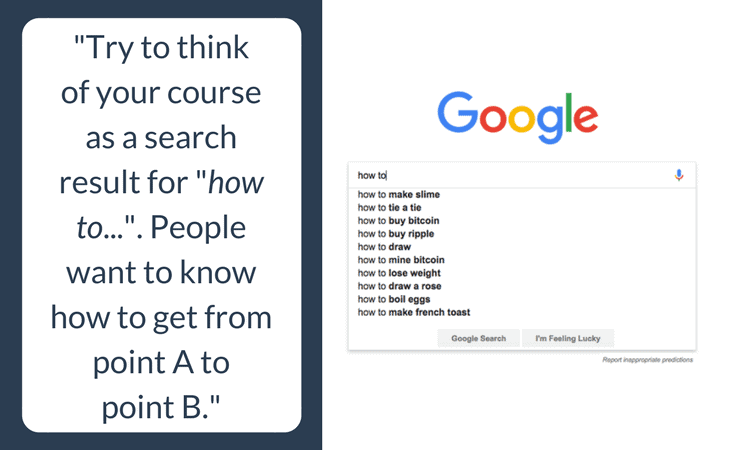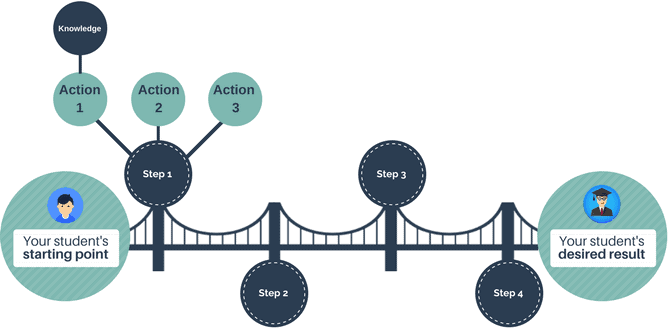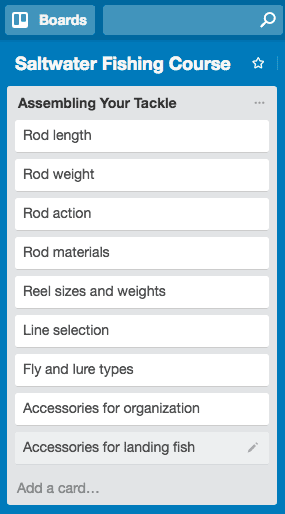
Creating a course outline now using this process can save you hours of wasted time during your course content creation process and lead to more effective learning outcomes for your students.
Article Index
- Rule #1: Use the least number of steps possible.
- Rule #2: Use background facts and supplemental details sparingly.
- Rule #3: Use simple language and ideas in your outline.
- Step 1: Begin with the end in mind.
- Step 2: Determine each major step necessary.
- Step 3: Create the action steps required to successfully reach each milestone.
- Step 4: Outline the knowledge required for each of your action steps.
- Step 5: Create a lesson sketch for each task.
Article Resources
Wait...we really need an entire guide on how to create course outlines?
I know, I know...
It sounds like a pretty cut and dry process, right? Open up a mind map, throw some course modules and units on the board, and get busy creating lessons.
But trust me...the more thought you put into your course outline prior to starting the content creation process, the more effective your course will be in helping your students reach their goals and the more efficient your workflow will be when you do create content.
And the word of mouth testimonials that you'll gain from turning your students into raving fans of your course combined with the time savings you'll gain during the content creation process will be well worth the time you invest in this step!
First, let's establish some ground rules!
Before we dive into the process of creating your course outline, I want to introduce three simple rules that you need to keep in mind. Understanding these rules prior to beginning your course outline will provide a lens through which you can view the outline creation process.
Here we go...
Rule #1: Use the least number of steps possible.
Think of your course as a bridge.
It's a bridge designed to take your students from where they are now (their familiarity with a topic or their current skillset) to where they need to go. If you worked through our guide on how to set effective learning objectives for your course, you'll already know what your student's destination needs to be.

Our goal is for this bridge to be as short as possible.
Determine the steps that are required to go from where your ideal student is right now to where they need to be after finishing your course and reduce the process to the least number of steps possible.
Think of your course as a search result for "how to X". Your students want to be able to learn a particular skill or gain proficiency in a subject as quickly as possible.

Rule #2: Use background facts and supplemental details sparingly.
For first time course creators, we've also noticed a tendency to establish absolute authority on subject matter through the inclusion of absolutely every detail and background fact that could possibly be provided.
But have you heard the phrases information overload or paralysis by analysis?
Your students can only assimilate a finite amount of information throughout your course. We want to ensure that we're giving them the best shot at successfully mastering a skill or knowledge by asking them to focus on the most important details.
Rule #3: Use simple language and ideas in your outline.
We very often see relatively simple concepts explained as if they were components of a graduate-level university course. You do need to establish authority on your subject matter, but as you create your course outline try to use simple language and ideas to do so.
Again, your students have a finite attention span for consuming your course content. We want them using brain bandwidth to learn and retain important concepts, not trying to decipher complex phrases or course pedagogy.
Now that we've covered these three ground rules, let's walk through the steps for creating an effective course outline!
Step 1: Begin with the end in mind.
Again, in an earlier article of the Course Creation Blueprint series, we discussed how to set effective learning objectives for your students.
If you haven't gone through that process, please take the time to do that first. We can't create an effective course outline if we don't know precisely what outcomes we want our students to experience. Without knowing the end result of our course, we're building a bridge without a destination.
This destination could be...
- How to start an online business
- How to use a digital camera
- How to catch saltwater fish
We recommend signing up for a free MindMeister account to create a mind map which can be used to create your course outline.
Once you have established the result your students can expect, we can move to the next step.
PRO TIP: If you've had trouble establishing concrete learning outcomes or course results, a great place to find inspiration is Amazon. Most book titles listed on Amazon allow you to preview the table of contents for each book. These table of contents previews can be a big help in getting your creativity flowing freely when thinking about course outlines.
Step 2: Determine each major step necessary.
The next step in creating your course outline will be to determine each of the major steps that will be required to take your student from where they are now to the desired result.
If your course is a bridge, these major steps are the foundational supports which hold up the road. We're not diving into the minutiae, tasks, and details yet, but we're going to stay focused on the broad strokes.
For example, if your course is intended to teach a student how to catch saltwater fish, the major steps in reaching that result might look like this:
- Purchasing the proper tackle
- Preparing the fishing tackle
- Finding good fishing locations
- Setting up a proper fishing spot
- Using effective casting techniques for the location
- Setting a hook and landing a fish
- Storing and cleaning the catch
Each of these major steps include a number of details. When preparing fishing tackle, for example, the student needs to learn how to properly spool fishing line onto a reel. But in this step of our course outline, we need to pinpoint the fundamental steps and we'll fill in the details later.
Step 3: Create the action steps required to successfully reach each major step.
Now that we have milestones in place in the form of the major steps that our student needs to take to reach a desired result, we can begin listing each action step necessary to reach those major milestones.
Using our fishing example, if we want our student to assemble the proper tackle they'll need to use to be able to catch a specific species, we would want to inform them about how to select:
- Rod length
- Rod weight
- Rod action style
- Rod material
- Reel size and weight
- Line selection
- Fly and lure types
- Accessories for organization
- Accessories for landing fish
In the end, each of these will likely become individual lessons within our course. But we are not diving into the details quite yet. We simply want to brainstorm all of the individual actions which need to be taken to reach each of our milestones.

Step 4: Outline the knowledge steps required for each of your tasks.
Now that we've filled in our course outline with major milestones and the specific actions steps a student will need to take to reach each of those milestones, we're going to take our next step.
For each task associated with reaching a major milestone, we need to give our students the knowledge to take an action or make a decision.
Let's use our major milestone of assembling our fishing tackle and our action step of choosing the proper rod length. There are a number of things we would want our student to know so that they can select the proper rod length for the location they'll be fishing in, their ability level when casting, and the species of fish they want to catch.
If we've decided to create a lesson on choosing the proper rod length, we would want to explain:
- How different rod lengths affect casting
- How different rod lengths affect the action of the rod
- How different rod lengths can be used to avoid obstacles or make long casts
- How different rod lengths affect the ability to land fish of different sizes
- How to select a rod length which performs in a variety of different locations

What's critical to keep in mind during this step are the 3 rules we listed above!
When discussing rod length for example, we don't need to lecture about how rod lengths were much different 60 years ago because they were made with natural materials which performed differently than the rods we use now which are made with graphite composites.
Your student is selecting a fishing rod length today, not 60 years ago. So do your best to avoid the temptation to brain dump during this process and stick to the need to know material.
Step 5: Create a lesson sketch for each task.
This step takes your current course outline a bit further and it's one that will save you a massive amount of time when you begin creating your course.
This is also where we recommend switching from a mind mapping application such as MindMeister to a dedicated project management app like Trello (the free account is more than enough for our purposes).
Once you create your free Trello account, you will want to create a new project. After you create a project, you're going to create a board for each of your major milestone steps. We're going to begin thinking of these boards as our course modules, or a group of individual lessons relate to a topic.

Once we have our boards created to reflect our major milestones, or modules, we'll create a card for each of our action steps. These will become our course's lessons once we begin creating content.
Within each card, we can begin creating a sketch, or overview, of what we're going to include in each lesson. And at this point, everyone handles the process a little differently. However, creating these sketches now can allow you to create your course content much more efficiently.
What's most important is detailing what medium you'll be using for the lesson and the type of presentation you're going to use to teach the content of that lesson. Almost all of our course content utilizes video, so when we create sketches for our courses we generally first indicate what type of video it will be and the software we'll use to produce it.
For example, if we're going to teach a student how to set up a Google Adwords account, we would enter details such as...
Adwords account setup - screencast recording - Chrome and Screenflow
Then we create a sketch of our major talking points that we'll be using so that we're more efficient when we begin to produce our content.
At this point in the process, many experienced course creators will tell you to simply list bullet points associated with the major concepts you need to present within a lesson.
Personally, I disagree.
I very much enjoy writing and I'm not much of a presenter. That being said, I find that I can produce course content much more efficiently by actually writing out the entire script for my lesson. Most of the time, I don't read this script word for word when I record videos for a course, but going through the mental exercise of writing out what I should say leads to nailing a lesson recording on the first take in many cases, which can save a ton of time which might otherwise be wasted re-recording and editing content.
If you're an able and confident presenter, you may be able to nail first takes simply by creating talking point outlines. If not, try writing out scripts for each of your lessons. It requires some time to write them out, but even if you have to read them aloud while trying to sound natural it can end up taking less time overall.
What do these scripts include?
- Demonstrations
- Step-by-step how to guides
- Screencast details
- Stories
- Analogies
- Examples
You can include anything which you think will help drive home a concept. Just remember to keep it as brief as possible.
